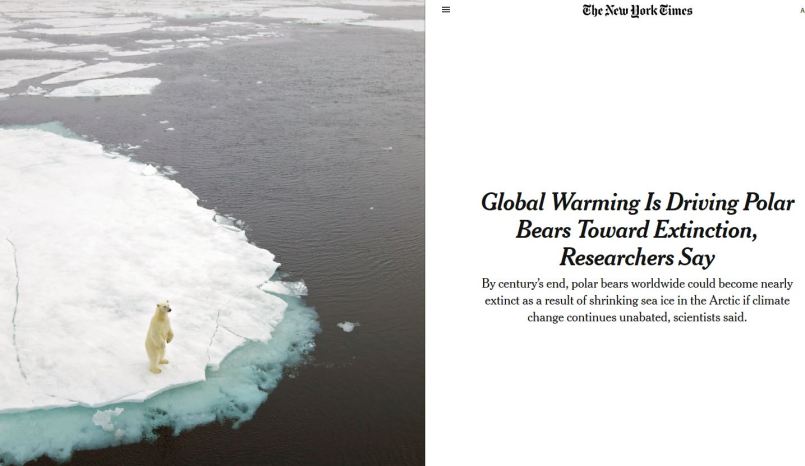TVNZ propaganda 21/7/20 “predicts” when Polar bears will allegedly become extinct due to Climate Change. Here’s the contradictory facts! MH

The health of the polar bear population runs counter to predictions from scholars who have said two-thirds of polar bears will disappear in coming decades because of warming temperatures and melting sea ice in the Arctic.The good news that polar bears are thriving is unlikely to draw as much attention as images of a starving polar bear scrounging for food on Somerset Island. Nevertheless, the story of a resurgent polar bear population deserves to be told and applauded.
https://fee.org/articles/the-myth-that-the-polar-bear-population-is-declining/
You can read Tv One’s item here:
Polar bears may die out by 2100 due to climate change
And some FACTS here:
UPDATE 22/7/20
New model of predicted polar bear extinction is not scientifically plausible
Apparently, a prediction that polar bears could be nearly extinct by 2100 (which was first suggested back in 2007) is news today because there is a new model. As for all previous models, this prediction of future polar bear devastation depends on using the so-called ‘business as usual’ RCP8.5 climate scenario, which has been roundly criticized in recent years as totally implausible, which even the BBC has mentioned. This new model, published today as a pay-walled paper in Nature Climate Change, also did something I warned against in my last post: it uses polar bear data collected up to 2009 only from Western Hudson Bay – which is an outlier in many respects – to predict the response of bears worldwide. The lead author, Peter Molnar, is a former student of vocal polar bear catastrophist Andrew Derocher – who himself learned his trade from the king of polar bear calamity forecasts, Ian Stirling. Steven Amstrup, another co-author of this paper, provided the ‘expert opinion’ for the failed USGS polar bear extinction model featured in my book, The Polar Bear Catastrophe That Never Happened.

Well, these authors and their supporters got the headlines they crave, including coverage by outlets like the BBC and New York Times (see below) but I have to say that the combination of using out-of-date Western Hudson Bay information on when polar bears come ashore in summer and leave for the ice in fall (only to 2009) to make vague projections (‘possible’, ‘likely’, ‘very likely’) about all other subpopulations in addition to depending on the most extreme and now discredited RCP8.5 climate scenario (Hausfather and Peters 2020) for this newest polar bear survival model is all that’s needed to dismiss it as exaggerated-fear-mongering-by-proxy. Why would anyone believe that the output of this new model describes a plausible future for polar bears?

Meanwhile, polar bear populations worldwide continue to thrive despite declines in sea ice. And as I have pointed out on numerous occasions, the ice free period for WH has not continued to decline since 1998 but rather has remained stable (with yearly variation) at about 3 weeks longer than it was in the 1980s (Castro de la Guardia et al 2017). Moreover, for the last five years at least, including this one, the ice-free season for WH bears has been better (only 1-2 weeks longer than the 1980s), although no official data on this phenomenon has yet been published. Oddly, this more recent data for Hudson Bay was not used for the Molnar model...Read the rest at header link.

Get your copy from our Online Store or your local book and magazine retailer
Australian Retail Locations » Uncensored Publications Limited
New Zealand Retail Locations » Uncensored Publications Limited
As censorship heats up and free thought becomes an increasingly rare commodity, we appeal to our readers to support our efforts to reach people with information now being censored elsewhere. In the last few years, Uncensored has itself been censored, removed from the shelves of two of our biggest NZ retailers – Countdown Supermarkets and Whitcoulls Bookstores – accounting for 74% of our total NZ sales.
You can help keep the Free Press alive by subscribing and/or gifting a subscription to your friends and relatives.








